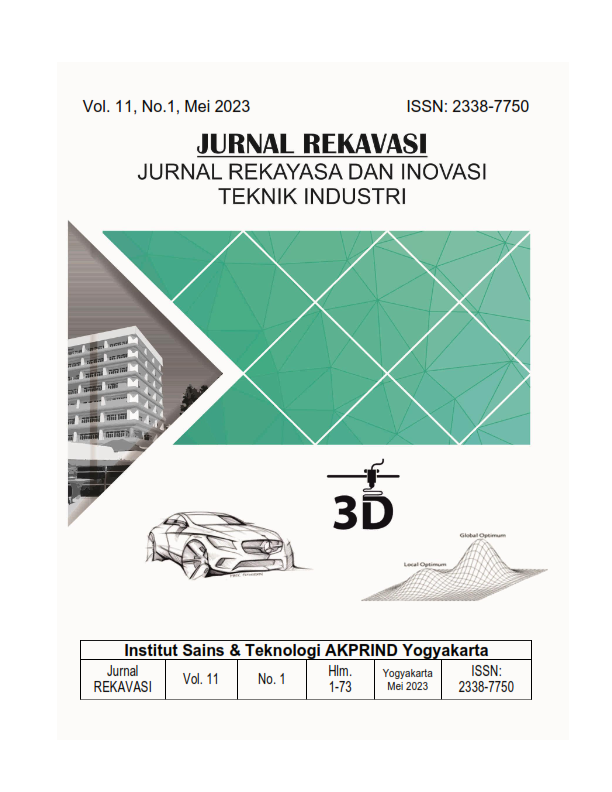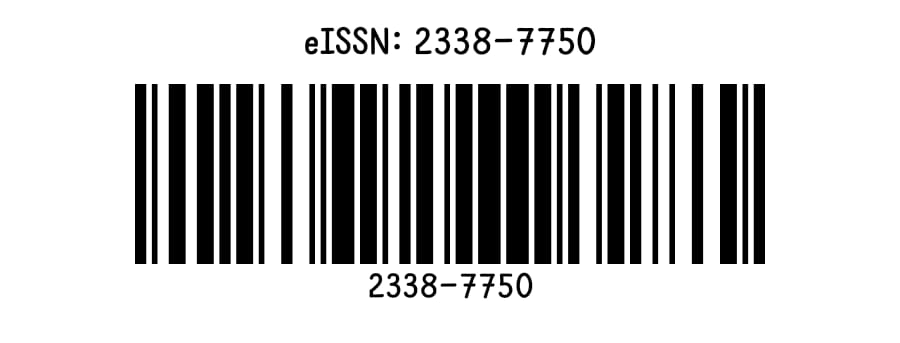USULAN PERBAIKAN WAKTU PROSES PRODUKSI MENGGUNAKAN METODE 5S, VALUE STREAM MAPPING, DAN PROCESS ACTIVITY MAPPING PADA UD NOK SUSI
DOI:
https://doi.org/10.34151/rekavasi.v11i1.4363Keywords:
5S, waste, Value Stream Mapping, Process Activity MappingAbstract
UD NOK SUSI is a business unit that produces rope, the purpose of this research is to implement 5S culture and reduce waste. Waste that arises from the remains of raw materials that have accumulated in production narrows the space for the production process and workers who make excessive movements often place tools/items haphazardly. 5S method (Seiri, Seiton, Seiso, Seiketsu, Shitsuke) to reduce waste. Stage Seiri (Brief) is an activity to separate equipment that is not needed. Stage seiton (Neat) is an activity to store goods that are fixed and so that goods are neatly arranged. The seiso (Rehearsal) stage aims to maintain cleanliness in the work environment. The seiketsu (Treat) stage is to continue carrying out activities in the form of sorting, cleaning and arranging the development of positive habits in the workplace. The shitsuke (Diligent) stage aims to get used to the 5S culture. Solutions to reduce waste can also be analyzed using value stream mapping to describe the flow of materials and information in the production process from raw materials to finished products. The VSM mapping results are used to map the PAM. Process activity mapping to map all activities in detail in order to reduce waste. Reduced wastage. sorting process, namely: untying, separating. Small spinning namely: preparing the small mill, moving the pellets. Big spinning, namely: pulling the rope, preparing the reel tool, taking the big spinning rope. Finishing namely: attaching labels. The cycle time obtained was 398.80 minutes which was previously 419.44 minutes
References
Dewi, S. K. (2018). Analisis Waste Pada Proses Produksi Dengan Lean Production. Seminar Nasional Teknologi Dan Rekayasa, 100–105.
Havi, N. F., Lubis, M. Y., & Yanuar, A. A. (2018). Penerapan Metode 5S Untuk Meminimasi Waste Motion Pada Proses Produksi Kerudung Instan Di Cv. Xyz Dengan Pendekatan Lean Manufacturing. Jurnal Integrasi Sistem Industri, 5(2), 55–62.
Mahesa, A. A., Utami, S. F., & Adiasa, I. (2021). Pada Ruang Proses Produksi Pupuk Organik Dinas. Jurnal Teknik Dan Sains Fakultas Teknik Universitas Tekonologi Sumbawa, 2, 59–65.
Novianto, D. (2019). Perencanaan Perbaikan Proses Produksi Dengan Metode Lean Production Dan 5S (Seiri, Seiton, Seiso, Seitsuke, Shitsuke) Ud. Karya. https://eprints.umm.ac.id/56381/
Reza, M., & Azwir, H. H. (2019). Penerapan 5S (Seiri, Seiton, Seiso, Seiketsu, Shitsuke) Pada Area Kerja Sebagai Upaya Peningkatan Produktivitas Kerja (Studi Kasus Di CV Widjaya Presisi). JIE Scientific Journal on Research and Application of Industrial System, 4(2), 72–81. https://doi.org/10.33021/jie.v4i2.892
Ristyowati, T., Muhsin, A., & Nurani, P. P. (2017). MINIMASI WASTE PADA AKTIVITAS PROSES PRODUKSI DENGAN KONSEP LEAN MANUFACTURING (Studi Kasus di PT. Sport Glove Indonesia). Opsi, 10(1), 85. https://doi.org/10.31315/opsi.v10i1.2191
Yudhanto, A. D., & Purwanto, P. (2020). Analisa Pengaruh Penerapan Budaya 5S Terhadap Produktivitas Karyawan Di Pt Samsung Electronics Indonesia, Bekasi. Jurnal Muara Ilmu Ekonomi Dan Bisnis, 4(2), 205. https://doi.org/10.24912/jmieb.v4i2.7609










